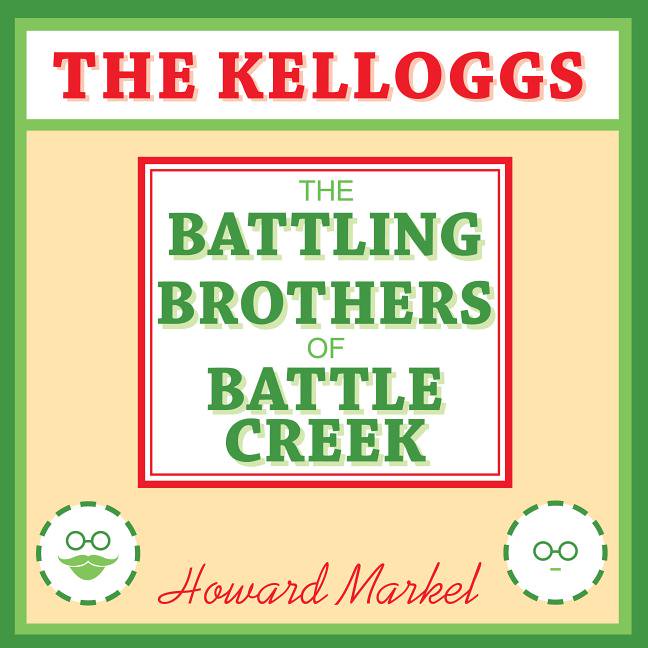Special Ks, Amazing Kelloggs
I pulled out a box of Kellogg’s Special K Original Toasted Rice Cereal to sit on the table while writing this post. It features a large red script “K” along with QR code to connect in a whole new way with the cereal company, promising a breadth of health and wellness hacks. Some things change over the years while others remain strikingly consistent.
The Kelloggs: The Battling Brother of Battle Creek is an outstanding history of the two brothers that reshaped American health, history and eating, and along the way, how that “K” wound up on my table. The author is Howard Markel, who brings a perfect set of skills and expertise to the effort. Markel has an MD and PhD, and he holds the George E. Wantz Distinguished Professor of the History of Medicine chair at the University of Michigan, while also directing the university’s Center for the History of Medicine. He’s prolific, award-winning, and knows just the right mix of scholarly rigor and accessible language to bring to the task at hand. And what extraordinarily rich material with the Kellogg brothers: they were extraordinarily successful leaders, each in their own right.
The elder of the two, John Harvey Kellogg (1852 -1943), was a doctor, first and foremost, and then an influential public figure. Raised in a Seventh Day Adventist family, he studied medicine and founded the Battle Creek Medical Surgery Sanitarium, one of America’s most influential hospital and health resorts. Kellogg was a very effective surgeon, an early proponent of germ theory, and an even more effective publicist for a wide range of views. He wrote and spoke on health reform, diet, water cures and a host of other topics. Many famous Americans were treated under his care in the Michigan sanitarium, as were many people who otherwise could not afford medical care. Markel is sympathetic to John’s brilliance, his enthusiasms and generosity, and candid about his many shortcomings. He was an erratic businessperson, often indifferent to details. John was proud, consistently seeking the spotlight and often picking unnecessary fights with others. In his latter years he was an advocate for eugenics, which is one of the reasons his reputation has suffered. And most germane to the dual biography, he was awful to his younger brother, William.
William Keith (W.K) Kellogg (1860 – 1951) toiled in his elder brother’s shadow for many years. He made the Sanitarium profitable. He was a tireless innovator and an indefatigable worker. W.K. was also much less of a public persona than his brother. More quiet, more reserved and in many ways simply less happy, W.K. struggled to break out on his own. As both brothers were involved in the creation of healthy foods, W.K. quit the Sanitarium and built Kellogg foods. The first major success was, and remains, Corn Flakes. Kellogg today is a global behemoth valued in the billions. W.K. managed money, expansion, many lawsuits (with his brother and with other business competitors) and did it very well. Markel is especially strong on explaining how W.K. understood the importance of marketing in a rapidly changing environment.
The latter decades of the 1800s and early part of the 1900s were a period of tremendous economic growth in the US. Mass markets were developing as the nation’s economic infrastructure – communication, transportation, manufacturing and distribution – grew at an extraordinary rate. The Midwest was producing more and more grains. The growing middle class was living longer, reading more, and seeking ways to improve health and quality of life. The intersection of healthy eating and mass production and marketing was the target for Kellogg’s company. W.K. saw this and was brilliant in taking advantage of the opportunities. He made sure, for example, that his signature and personal guarantee of quality was on every package of cereal. That script “K” is still with us today, as his invention of waxed paper to keep cereal fresh.
It is fascinating history and the two brothers were extraordinary people. Markel is very adept at giving each their due, highlighting their individual impacts in separate spheres and in shared spaces. The story intersects with many key trends in American history. The brother’s tangled relationship with the Adventist Church is one of those strands, as is the ways in which health, eating and sanitation were intertwined with progressive thought. The darker impacts of eugenics is not forgotten, either. What impressed me about Markel’s history was his consistent empathy with his characters. No apologist, Markel explains – and does it with vigor and clarity. Above all, his history is also about an unhappy family. The two brothers fought in private and in the courts. Their relationship was toxic and they never reconciled. Even with all that success, this history, in many ways, is a tragedy.
Superb book, well worth your time, The Kelloggs is an exemplar of strong scholarship rendered accessible.
David Potash
